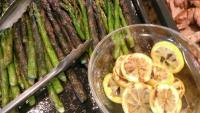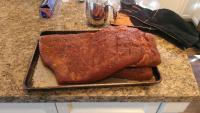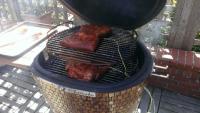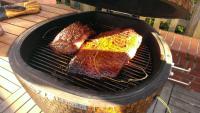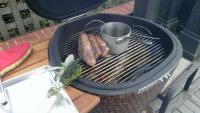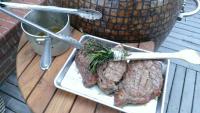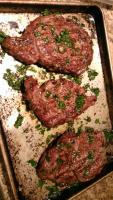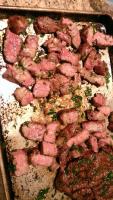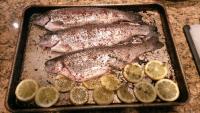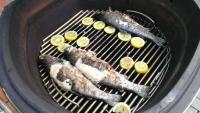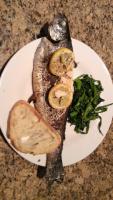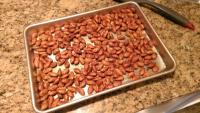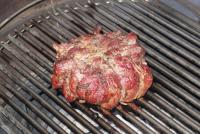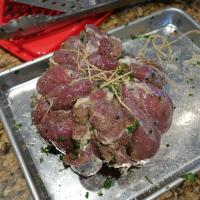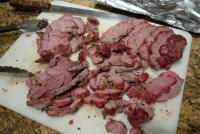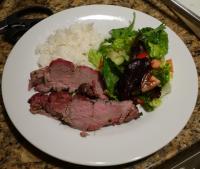-
Posts
49 -
Joined
-
Last visited
-
Days Won
2
Content Type
Profiles
Forums
Events
Everything posted by jmagaram
-
I have trouble with low temperatures on the 23". First, I have to be extremely precise in how far I twist the dial since a difference between just a few degrees on the dial can result in a big swing in temperature. There are no markings to guide me. Also, I need to squat down and in the dark try to see where the dial is. Lastly, when I want to shut down the grill I need to be very careful to make sure the dial is completely closed. If there is a better dial on the larger grill with markings then I'd happily upgrade. I'd love to be able to see precisely that when 1 hole is visible the temperature is 180, 2 holes open is 220, etc. I can't see a picture of what the dial is like on the bigger grill. I'm really curious about it.
-
Looks beautiful. I like those tiles. I wouldn't have picked vibrant blue from the photos on the KK web site but would now that I've seen them up close they are really varied and pretty. I'm curious how you find the size of the grill. Those small ones look so cute. I'm wondering how well it smokes - are the coals too close to the meat? And can you easily fit a whole chicken or two on there? I've got a larger one but have contemplated getting the small one for small cooks just for my family.
-
I think you should test the metal rod concept to see if it really reduces heat transfer. As for foil friendly, I've got a roasting pan with two handles and every so often I want to seal it tight with foil. The handles get in the way. If you wanted to make it easy to wrap with foil with NO gaps around where the handles are, make the handles jut out to the sides slightly leaving perhaps a 1 cm gap. That way the top edge of the pan is uninterrupted. Kind of tough to explain without pictures. Here is a roasting pan where the handles get in the way when wrapping... http://www.amazon.com/All-Clad-E8759964-Anodized-Roasting-Nonstick/dp/B00DJAIUNC/ref=sr_1_5?ie=UTF8&qid=1400472037&sr=8-5&keywords=roasting+pan Here is one that would be easier to wrap with foil. Basically you want the handles to jut out just enough that they don't touch the top of the pan but leave enough of a gap so you fit the foil in between the top of the pan and the handles. http://www.amazon.com/Cuisinart-MCP117-16BR-MultiClad-Stainless-Rectangular/dp/B0041Q409G/ref=sr_1_4?ie=UTF8&qid=1400472528&sr=8-4&keywords=roasting+pan In the end, if the bottom of the pan is larger than a single sheet of foil, then there is a chance the grease will seep through anyway, and the area around the handles is the least of the problems.
-
No. Bitter herbs are things like endive and horseradish.
-
Next time I'll put the meat in 3 to 9 o'clock but good tip on how to extend the indirect area. Brisket tasted good cold. Very easy to slice when cold out of fridge and fat separated too so it was easy to remove some of it. Serving it with some homemade BBQ sauce. Also some grilled asparagus topped with chopped charred lemon slices and lemon zest.
-
I forgot that I the recipe suggested I cook the meat fat side up for most of the time but flip for the 4th hour. That's when I switched it all to the main grate.
-
Finished cooking the brisket tonight without using the kitchen oven. The KK kept an amazingly stable 230 for a few hours before I foiled it. Then I threw it back on and it kept the same temp for another few hours. Amazing! I did cheat a bit by heat soaking the ceramic heat deflector in the oven while the grill got up to temp. Probably took about an hour to stabilize temp. I was being very cautious about getting it up to temp slowly. I was surprised how much meat I could cook. I put a full 11 pound brisket on the main grate and a flat 5 pounder on the upper grate. I probably could have fit both on the main grate. I switched to that configuration during the foil stage. I wonder if I could have used the lower grate for the second brisket instead or if it would be too hot. The big brisket got slightly charred on one end. I think the heat around the edge is extra hot while the deflector is in place. My recipe was from Raichlen BBQ USA. Did a spice rub overnight. While cooking he wanted me to spritz with apple juice every hour using the spray bottle. And before foiling it I gave it some more spritz and a coating of some reserved spice rub. When it was done I did not throw it back on to develop more bark. Too much hassle. I'm serving it tomorrow and plan to store it in the foil overnight. Tomorrow will warm it up in the foil before slicing. I haven't tasted it yet. Overall I'm very pleased with the whole process of cooking my first big brisket on the KK.
-
I am doing a brisket too but a different way. I'm going to smoke it in the kk for a few hours with a spice rub. Then foil it, add a small amount of liquid (not braising), and cook on low for many more hours in the kitchen oven. The first part of the cook gives it a smokey flavor and bark. The second causes the fat to break down so it is very tender throughout. I've tried braising a tough cut of meat before using the kk. First I cooked on low like 250 for a few hours and did a spice rub all over the meat. Then I took the meat and braised it by putting it in a dutch oven with enough liquid to come up about half way up the side. I added lots of uncooked vegetables to the pot - lots of onions, some peppers, garlic cloves. Definitely cover it - essential for braising - and then cook in oven on low heat till it is done. In my case I used beer as the braising liquid. The initial cook on the KK gave it a smoky bark that wasn't totally lost when I shredded it. I think this type of cook would work well with brisket. I wouldn't saute in pan first because I think the smoke won't penetrate as easily.
-
I think doing a sear over half basket and then indirect to finish them off might work, but I have no first-hand experience with it. I'm wondering a similar thing. I've got 3 steaks in the fridge and wonder if and how I should use the basket splitter. I want to do reverse sear and first do a slow cook, like 300 degrees, until internal steak temperature is 95. And then sear it very hot. I want to minimize the amount of wasted coal. I know that when you shut all the dampers the coals are supposed to go out, but from my experience I think (but am not sure) they keep burning a bit leading to some waste. There have been a couple times when the coals weren't totally extinguished the morning after. I could use full basket at low temp and cook on lower grill and then remove the steaks to rest. During the rest I'd hair-dryer the coals to get the temp up and then sear on the searing grate. One option here for a gentle first cook is to use the heat deflector but it might use up a bunch of coal getting the grill heat soaked at 300 which goes against my goal of a quick week-night cook. Or I could just use a half basket which is probably enough fuel for 3 steaks. For the slow cook I'd get the coals to moderate temp and put the steaks on the indirect side, maybe on the lower grill. I'd then pump up the temperature of the coals and move the steaks to the searing grill and cook right over the coals.
-
Not the searing grate? Does it burn for you? Get a nice crust? Do you use a high temp?
-
Grilled rib eye using a technique described by Adam Perry Lang in Charred and Scruffed. Amazing flavor. Super tender. There are a lot of aspects to the recipe but I actually think the key thing is frequent basting with butter. Here are the steps. If you want the details buy the book. Score the steaks so there are more nooks and crannies for the flavors. Rub with mixture of salt, pepper, garlic salt, and cayenne. Make an herb brush with thyme, rosemary, and sage. Make a basting liquid with olive oil, butter, garlic, onion, soy sauce, thyme, lemon, and vinegar. I used the basket splitter so I'd have a cooler workspace on the grill. At a medium temp I cooked the steaks on the main grate, turning frequently, and basting using the herb brush and basting liquid. Cooked them on their sides too by leaning them against the saucepan that had the basting liquid. Once steaks reached 95 degrees internal I took them off and rested them for about 10 minutes. Removed main grate and left the searing grate on the second-to-lowest position - the tall handles down. Turned up the heat a bit but the dome temp didn't get more than maybe 425. I could have cranked it up or cooked on the lower position but was worried about burning the meat and basting liquid. Seared on the searing grate again with turning every minute or so, basting throughout. Took meat off and put on a cookie sheet covered with a sauce of oil, parsley, and garlic. Chopped the top of the herb brush and mixed it in. After letting steaks rest a few minutes I sliced them and tossed them around in the sauce. Absolutely delicious! Perfect medium and medium rare. Had a light crust. Next time I might take one of the steaks and try to sear at higher temp for more crusty texture but flavor-wise it was close to perfect.
-
My basket splitter came with 4 pieces and I'm not clever enough to figure out how to use them. Some photos would be handy along with tips about when to use the different pieces. I think I figured out I can put the vertical divider into the charcoal basket to split it exactly in half. And then there is a solid half moon I can lay on top of one half to presumably block and direct fire that comes up from one side. Would you ever use the half moon without the splitter? And there are two half moon grates that I don't know how to use. Is there any guidance on how to orient the charcoal basket when the splitter is in use?
-
Do you get a commission on these sales? Why are these grates better for fish? Is it easier to turn with that special spatula?
-
I've only been cooking on the KK for a couple weeks now and am still getting the hang of achieving my desired temperature. For the first few cooks it got too hot. Recently what I've done is lit a single paraffin started cube, closed the lid, and immediately set the dampers to where I think I'll get the desired temp. So if it is 250 degrees, for example, I'll close the dampers almost all the way. Then I just wait and wait. It can take a very long time - like over an hour - to get the grill up to my desired temperature. I watched a video for a different kamado where the cook used a different approach. He progressively closed down the dampers as it was heating up. For example, maybe the dampers were completely open for 10 minutes before he closed them down a bit. And when the temp got to 150 he closed them more. And when the temp got to 200 he closed them more. And so on. I'm wondering what people do to quickly get the grill up to say 225, 300, and 400. Does the progressive approach work? Or do you just need to be very patient and initially set the dampers where you want them in the end?
-
I rubbed some trout with olive oil and seasoned with salt, pepper, and sumac. Stuffed body with thyme sprigs. Used regular lump and no smoking wood. When grill was around 300 after about 30 min I put them on the lower rack and turned a couple times. Total cook time around 20 minutes mostly lid closed. I also coated some sliced lemon in olive oil and put the slices on the rack with the fish. Pretty tasty. Some smokiness. I had trouble not breaking the akin when turning and the skin wasn't as crispy as I would have liked. Flavor was very good. The lemon slices were amazing. Some got a little charred and the acid was a wonderful complement to the richness of the fish. Served it with some rapini that I had boiled briefly and then drained and chopped and tossed with sautéed garlic, anchovies, and red pepper flakes. I'm not sure how to get a crispier skin. Also don't know how to avoid breaking the skin when turning. Finally the heat on the lower grill was pretty uneven since the center had the hot coals. I'd like to shorten the cook time so the smoke flavor is more subtle. Worried that if I increase heat and do lower grill they'll burn.
-
I've also got a "splatter screen" that I put over pans on the stove to keep the oil from getting everywhere. That might work though it won't fit on the center of the grill because of the handle.
-
Mine tasted better today. Actually the wife and I ate a lot of them. The spices stuck pretty well with just 1 tsp olive oil per cup of almonds. I think I should have raised the temp at the end for more crunch. Still think a perforated metal pan would get more smoke flavor but it had a decent amount of smoke flavor done on the cookie sheets.
-

First Calzones on the Komodo Kamado
jmagaram replied to Hector's topic in Bread, Pizza, Pastries or Desserts
Those look pretty good. Like the metallic tiles! -
Success! This was the first time I was able to keep a low temperature - steady 250. Lit just a tiny amount of coal in the center. Closed the bottom damper to about thickness of dime. Top damper like a quarter revolution open. Took about an hour to reach temp. Put on a chunk of hickory. Tossed two cups almonds with 2 tsp olive oil. Mixed in salt, black pepper, brown sugar, and ancho chile pepper. Put them on a cookie sheet on main grate for about an hour. Texture pretty good. Maybe needed to go a bit longer since somewhat soft not crunchy enough. Or maybe they'll crunch up as they cool more. Not a whole lot of smokey flavor. Maybe better to cook on a perforated piece of metal. Got to find a great recipe for this.
-
Followed a recipe from Cooks Illustrated. Took a 4 lb butterflied boneless leg of lamb and spent about 30 minutes trimming off all the fat I could. Ended up with 3 big pieces and several smaller bits. Brined in water, salt, sugar, and tons of crushed garlic for about 2 hours. Dried the pieces off and cut crosshatch slits about 1/4 inch deep in the big pieces. Rubbed roasted garlic paste and parsley into these slits. Then attempted to roll it all back up and tied it together into a somewhat ugly mess. Salted and peppered the outside. Cooked on main grate indirect at around 375 until inside was around 125 degrees, about 75 minutes. Then I took out the heat deflector, raised the heat up to around 425, and tried to sear it slightly on the searing grate for about 5 min per side. Let it rest about 15 minutes under foil and then sliced. I ran out of heat/charcoal during the searing phase and couldn't get the temperature up much. I overcooked it during the searing phase - went from medium rare to well done. Probably should have started the searing much earlier like around 110 degrees or skipped it altogether. It tasted pretty good despite being overcooked. Very strong garlic flavor. Too much for the wife but nice for me.
-
I'm not sure which one is the sear grill. I used the lower grill, this one with small handles. I did not use that reversable one with short handles on one side and long handles on the other. I wonder if there would be less flare ups with the lid closed for searing since less oxygen going on there. On the other hand I won't be able to watch and make sure nothing bad is happening. Makes sense about not heat soaking when high heat grilling.
-
I've cleaned out the ashes a couple times and it is a messy job. First need to shake the charcoal basket and this gets the dust flying. After waiting for it to settle I spray a few times with a water bottle and then use a brush to brush it all near the door. This also gets the ash flying. Take out the deflector and take off the door and then brush the ashes into the stainless drip pan which I've set on the ground. Again the ashes go flying. If it were windy I couldn't do it this way since the ashes would go flying when they got brushed out the door. I'd consider buying a shop vac but don't want the hassle or another piece of equipment. I wonder if I could fit a Pyrex pie plate or carbon steel skillet at the base to collect the ashes. Then I'd just loft it up and out and dump into a bag. Has anyone done this?
-
I looked for a vice but my impatience got to me. It wasn't too difficult to bend the smokehouse armored probe with my hands. I used a small cloth towel to get a better grip on one side and was careful not to tweak the cable. Needed about a 160 degree angle to fit through. Did a temp test later and it compared fine to another probe from Thermoworks that hadn't been bent. Sent from my All Series using Tapatalk
-
I am having trouble maintaining temperatures too. I've only done a few cooks. For the first one, I lit lots of the charcoal in many different spots using a Looftlighter with the vents open and then closed them down substantially after about 10 minutes. The temp got much higher than I wanted. For my second cook I undershot it. Tonight I nestled a paraffin cube in the top/middle of the coals, lit it, and immediately closed the lid and closed down the dampers a lot without even waiting to see if the paraffin cube caused the coals to get going. Well they did get going. I was aiming for about 275 but it got to 330. I will keep trying to learn. So far it seems that it is REALLY important to light the bare minimum amount of charcoal in the beginning (like what I did with the paraffin cube) AND to keep the dampers barely open AND expect to wait at least an hour for the temperature to get where you want. Once the temperature gets above the goal it is extremely difficult to bring it back down. I tried closing off all the dampers completely and the temp did drop 40 degrees. Then I got nervous I was going to extinguish the coals and barely cracked the dampers open again, which caused the temp to spike again. Is this a reasonable strategy for bringing the temp down? How long can you close off the dampers before the fire is totally extinguished, and does this make the food taste bad since it is trapping some smoke in there? The manual talks about "x turns of the upper damper" and am not clear what this means. What is a full turn? I assume a full turn of the upper damper means 180 degrees since that brings the metal fins back to where they started. If anyone has more specific guidance here about reaching and maintaining goal temps I'd love to hear it. Sent from my All Series using Tapatalk
-
Today I did some thick New York strip steaks. Followed the Cooks Illustrated reverse sear method and it worked pretty well. Cut each in half, good when sharing a 1 pound steak with two people. Salted it and then threw it on heat soaked main grate at 330. Should have been 275 according to the recipe but couldn't control the heat. With temp probe got each steak to ONLY around 95-105 and took off. Got grill raging at 700 but NOT ceramic heat soaked, and did about 2 min per side on lower grate. Rested about 8 min under foil. All the steaks had a decent crust and very thin layer of gray at the edge and was nice medium rare throughout. First time I've cooked steaks on the grill. Peppered them at the table since I was worried the heat would make the pepper bitter. If I could do it again I'd keep the temp at 275 and would sear them a bit longer for more crust. I did the sear with the lid open. Was that correct? I saw a bunch of flames shoot up. Not enough to char the steak but worrisome. Also, should I have gotten the grill more heat soaked at the high temp?


